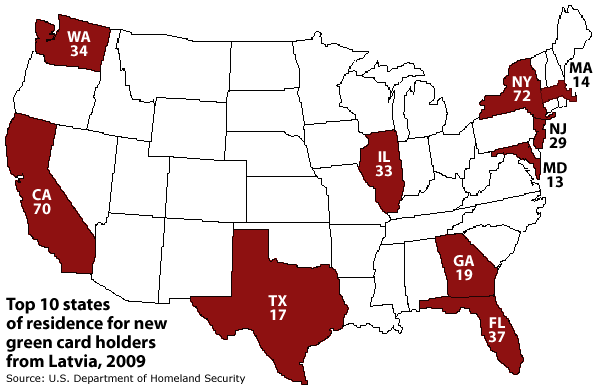
U.S. Department of Homeland Security statistics reveal which 10 states have the most new legal permanent residents from Latvia. (Illustration by Latvians Online)
The number of persons from Latvia who have become legal permanent residents of the United States dropped last year to its lowest point in the past decade, according to recently released government statistics.
However, the latest edition of The Yearbook of Immigration Statistics, prepared by the U.S. Department of Homeland Security (DHS), reveals that tourist and other non-immigrant admissions from Latvia continue to rise.
The 444 persons born in Latvia who in 2009 became legal permanent residents—also known as holders of “green cards”—continued a declining trend that began after peaking in fiscal year 2006. That year, 892 persons from Latvia became legal permanent residents.
Of those who became legal permanent residents last year, nearly 69 percent were immediate relatives of U.S. citizens. Nearly 68 percent were female, according to DHS statistics. The majority, 67 percent, were 34 years old or younger.
The state with the most new green card holders from Latvia was New York, with 72 persons. California was second with 70, followed by Florida (37), Washington (34), Illinois (33), New Jersey (29), Georgia (19), Texas (17), Massachusetts (14) and Maryland (13).
Meanwhile, the number of persons from Latvia admitted to the U.S. as non-immigrants, including tourists, students and business travelers, rose to 15,892 in fiscal 2009, according to the statistics yearbook. That is more than a 9 percent increase over 2008.
Latvia joined the U.S. Visa Waiver Program in November 2008, meaning Latvian citizens no longer need to apply for a visa to visit America.
Of the non-immigrant admissions, 641 were students or individuals involved in other exchange programs.
According to other statistics reported in the yearbook:
- In 2009, a total of 27 children from Latvia were adopted by U.S. citizens. Of those, 11 are boys and 16 are girls. Four-fifths of the children were age 5 or older.
- A total of 404 persons born in Latvia became naturalized U.S. citizens in 2009, a decline from the 455 reported in 2008.
- Three persons from Latvia last year were granted asylum in the U.S.
- A total of 27 persons from Latvia were removed from the U.S. in 2009, three of them for criminal convictions.
DHS reports immigration statistics throughout the year, but prepares the yearbook for release in August, according to the department’s website, www.dhs.gov.




